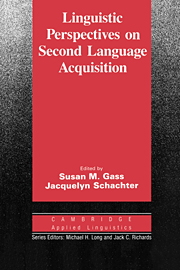Book contents
- Frontmatter
- Contents
- List of contributors
- Series editors' preface
- Introduction
- I THEORIES OF ACQUISITION
- II SYNTAX
- Chapter 3 Testing a proposed universal
- Chapter 4 The role of the head-initial/head-final parameter in the acquisition of English relative clauses by adult Spanish and Japanese speakers
- Chapter 5 On some properties of the “pro-drop” parameter: looking for missing subjects in non-native Spanish
- Chapter 6 The adjacency condition on case assignment: do L2 learners observe the Subset Principle?
- III SEMANTICS/PRAGMATICS
- IV LEXICON
- V PHONOLOGY
- Index
Chapter 4 - The role of the head-initial/head-final parameter in the acquisition of English relative clauses by adult Spanish and Japanese speakers
Published online by Cambridge University Press: 05 October 2012
- Frontmatter
- Contents
- List of contributors
- Series editors' preface
- Introduction
- I THEORIES OF ACQUISITION
- II SYNTAX
- Chapter 3 Testing a proposed universal
- Chapter 4 The role of the head-initial/head-final parameter in the acquisition of English relative clauses by adult Spanish and Japanese speakers
- Chapter 5 On some properties of the “pro-drop” parameter: looking for missing subjects in non-native Spanish
- Chapter 6 The adjacency condition on case assignment: do L2 learners observe the Subset Principle?
- III SEMANTICS/PRAGMATICS
- IV LEXICON
- V PHONOLOGY
- Index
Summary
One of the most widely investigated structures in adult second language (L2) research is restrictive relative clauses. One reason for this is that though they are the principal structural devices used by languages of the world for encoding recursion, they can vary considerably in terms of their distribution and syntactic forms. For example, languages can differ with respect to the noun phrase (NP) positions that can be relativized, with respect to the nature of the complementizer used, and with respect to their use of resumptive pronouns. At a more abstract level, these structures differ configurationally across languages. Following from the head-direction parameter (defined more fully later), relative clauses can be head-initial as in English, they can be head-final as in Japanese (Kuno 1973), or they may be medially headed as in Hindi (Comrie 1981). Because of these properties, relative clauses provide a unique and an important domain of investigation of L2 learning. By systematically varying both the first language (L1) of adult learners and the target L2 to be learned, we can isolate in what ways and at which levels knowledge of the L1 may “mediate” the L2 acquisition process. At the same time, we can isolate ways in which principles independent of L1 knowledge determine patterns of acquisition (see Gass and Ard 1980; Tarallo and Myhill 1983 for related discussions).
Traditionally, L2 studies within this domain have focused on differences between the L1 and the L2 in terms of their distributional and surface structure syntactic properties.
- Type
- Chapter
- Information
- Linguistic Perspectives on Second Language Acquisition , pp. 89 - 108Publisher: Cambridge University PressPrint publication year: 1989
- 10
- Cited by



